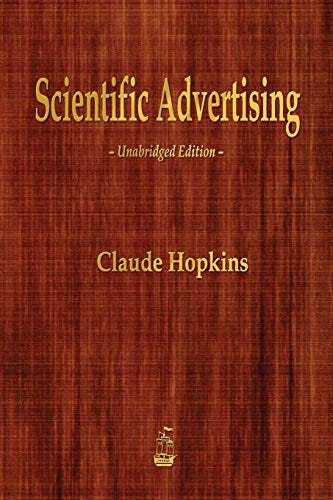The 16 Principles of Scientific Advertising
Plus: An inspiring Steady Eddie, 11 recent tests & a mighty mini mop
After receiving a positive reaction to my interview with Brett Curry, where I shared some of the knowledge I gained from the ‘Masters of DR,’ I am excited to introduce a new (free) feature. Working name below.
In this section of the newsletter, I plan to share high-impact direct selling techniques and principles that all marketers can apply immediately to their campaigns. As the self-proclaimed historian and librarian of this industry, you can also expect great excerpts from the forgotten writings of the founders of our craft. Ready? Let’s go!
DR Dynamite!🧨
Claude had to be the one to kick this thing off…
Hopkins’ 1923 classic, Scientific Advertising, had such a profound impact on my thinking about advertising that I named my company (and thus this newsletter) after the book. That’s right, mystery solved — “SciMark” stands for Scientific Marketing.
So, for the inaugural DR Dynamite, I’m going all out by sharing not just one but all 16 of Hopkins’ principles of scientific advertising. I’ll quote and summarize them below.
“Regardless of principles, we must always experiment. But there are certain basic laws so well established, so generally accepted by those who know returns, that all who are wise will recognize and generally employ them.”
Brilliant writing has no place in advertising. One should be natural and simple. Never try to show off.
From start to finish offer service.
Forget yourself entirely. Have in your mind a typical prospect, interested enough to read about your product.
Do not boast. Boasting is repulsive.
Aim to get action. People are dilatory. They defer action, then forget. One cannot afford that.
Frivolity has no place in advertising. Spending money is usually serious business. Money comes slowly, and by sacrifice.
Never seek to amuse. The only interest you can offer profitably is something people want.
Make every word count to the limit. Cut every word that is not worth $10. Never repeat.
Do not waste space in any way. It is expensive.
Tell the full story. People do not read ads in series. All appeals which prove themselves important should be included in every ad.
Superlative claims do not count. Give actual figures, state definite facts. Indefinite claims leave indefinite impressions.
Never advertise negatively. Always present the attractive side, not the offensive side of a subject.
All experience in advertising proves that people will do little to prevent troubles.
There are many things in advertising too costly to attempt. The world is full of things that appeal to the 1 percent.
A simple change in headline can multiply results from an ad by eight or ten.
The best school is canvassing, going from home to home. Many great ad writers spend half their time in that.
“Every ad is surrounded by countless appeals. Every effort involves much expense. The man who wins out and survives does so only because of superior science and strategy. He must know more, must be better grounded, must be shrewder than his rivals. The only way to that end is to start with fixed principles, proved by decades of experience, from which you never swerve.”
Exactly 100 years after it was published, Scientific Advertising is still highly relevant and full of mind-expanding insights. If you haven’t read it, fix that immediately!
Chart Watch 🆓
Hydro Mousse
Pitch: “Grass grows where you spray it”
Marketer: Eagle Eye
I’m calling out this old campaign as a prime example of what we should all aspire to own — a ‘Steady Eddie.’ According to DRMetrix, this campaign has been running for 257 weeks (that’s nearly five years) and was #7 in spending last week.
Seasonality used to be a big negative on my list of criteria for DRTV products, which made perfect sense when brick-and-mortar retail dominated the market because it was devilishly hard to get the inventory right. Besides, the goal was having the highest odds of success possible, and limiting sales to a certain time of year was an obvious handicap. A few campaigns changed my mind.
One was Hampton’s Twin Draft Guard. Another was Allstar’s Magic Mesh. One only worked during cold weather, the other only during warm weather, but they both kept coming back, season after season.
The final campaign that changed my mind was Telebrands’ Star Shower, which was absurdly successful despite having the shortest selling season imaginable (the holidays). Although we can question whether Telebrands managed to have the right supply to meet demand, there is little doubt that they made millions.
Now that online retailers like Amazon are dominating the DR marketing space, seasonal campaigns make more sense than ever before. Eagle Eye deserves kudos for continuing to maximize this perennial winner.
Recent Tests🔒
Those eight new tests I wrote about last week? Yeah, now it’s 11. They seem to be coming in pairs. That is, I’ve logged two from Emson, two from Telebrands, two from IdeaVillage and so on. Below, I analyze the one I found most interesting this week.
{Note: If you want to review all 11 tests, and you don’t already have access to my archive (The Library of DRTV), shoot me an email. I’ll send you the links to the spots as an extra thank-you for being a premium subscriber.}
Battle Vision Wrap Arounds
Pitch: “Fit right over your prescription glasses or readers”
Marketer: BulbHead
This is the fourth attempt at Battle Vision-branded sunglasses by Telebrands (also known as BulbHead). The first attempt was in 2018 with Atomic Beam Battle Vision, which was launched in response to our Bell+Howell TaGlasses. Both campaigns were ultimately successful, along with a late third entry from IdeaVillage called HD Vision Special Ops. When all the spending was said and done, Special Ops came in at #10, TacGlasses at #12, and Battle Vision at #37 on the True Top 50 that year.
In the same year, Telebrands tested Battle Vision Blue Brite, which did not gain much traction. Then in 2021, the company launched Battle Vision Storm. That one became a True Top 50 hit.
As for this latest attempt, “Wraparounds” is an IdeaVillage concept and brand name first introduced in 2008. These sunglasses are also similar in concept and pitch to our Flip-Up TacGlasses, which were a 2019 True Top 50 hit.
Of course, there has been nothing really new about any of these sunglasses for decades. That is, they’ve all featured the same blue-light blocking lenses. In that regard, we followed IdeaVillage (HD Vision), IdeaVillage followed Telebrands (Ambervision) and Telebrands followed Joseph Sugarman (BluBlockers) — which brings us all the way back to the 1980s.
There truly is nothing new under the sun, especially when it comes to sunglasses.
Promising Products🔒
Just one interesting item this week, but it comes with fun animated graphics!
Portable Mini Mop
Source: Up Catchy
This is like the handheld version of Top Dog’s Mighty Thirsty Mop. There are four reasons it caught my eye. First, it’s small enough for counters and tight spaces…
Second, it wrings out without you having to touch it…
Third, it does all the cool DR demos we’ve come to expect…
And finally, it’s easy to store and keep handy…












My three all-time favorite books on Advertising:
1. Scientific Advertising. The text book. Simply brilliant. "People don't buy from clowns"
2. Confessions Of An Advertising Man. David Ogilvy, the Wizard of Adz. "Study the methods of your competitors and do the exact opposite."
3. Spray The Bear. Walter Bregman's anecdotal shorts are a different style read. A glimpse behind the scenes of the golden age from a true adman. It's the real Mad Men.
Whats your list?